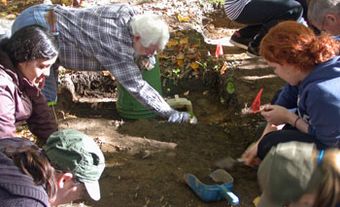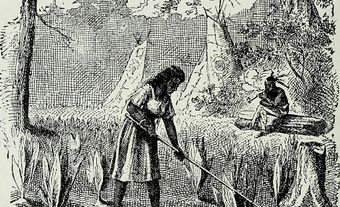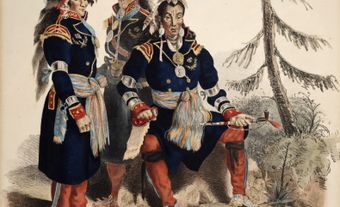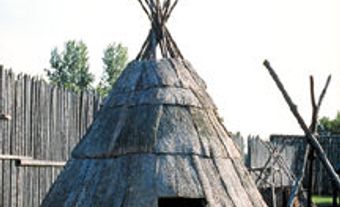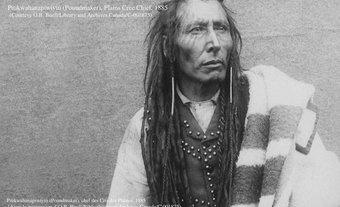The Wendat (also known as Huron-Wendat) are an Iroquoian-speaking nation that have occupied the St. Lawrence Valley and estuary to the Great Lakes region. “Huron” was a nickname given to the Wendat by the French. It means “boar’s head” from the hairstyle of Wendat men, or “lout” and “ruffian” in old French. Their confederacy name was Wendat (Ouendat) meaning “island dwellers.” During the fur trade, the Wendat were allies of the French and enemies of the Haudenosaunee. Following a series of 17th century armed conflicts, the Wendat were dispersed by the Haudenosaunee in 1650. However, the Wendat nation (Nation Huronne-Wendat) still remains, and is located in Wendake, Quebec. According to the 2021 census, 6,980 people claimed Wendat ancestry.

Territory and Population
Historically, the members of the Wendat confederacy were the Attinniaoenten (“people of the bear”), Hatingeennonniahak (“makers of cords for nets”), Arendaenronnon (“people of the lying rock”), Atahontaenrat (“two white ears,” i.e., “deer people”) and Ataronchronon (“people of the bog”). Each of these peoples were termed by the French as “nations.” This meant that they were separate political and territorial entities, with similar cultures, a common origin in the distant past and similar languages. (See also Indigenous Territory.)
The “Bear” and the “Cord Makers” were the original inhabitants of what is now northern Simcoe County in Ontario. In the late 16th century, the other three nations migrated from the north shore of Lake Ontario and the Bay of Quinte area. They joined the Bear and Cord in a loose defensive alliance against their common enemy, the five Haudenosaunee nations south of the lake. At the time of the destruction of the Wendat homeland (sometimes known as Huronia) by the Haudenosaunee, in 1649-1650, about 500 Wendat left Georgian Bay to seek refuge close to the French, in the Quebec City region.
Prior to 1600, the Wendat numbered about 20,000 to 25,000 people, but between 1634 and 1642 they were reduced to about 9,000 by a series of epidemics, particularly measles, influenza and smallpox. Today, the Wendat nation in Wendake, Quebec numbers 5,155 registered members, as of April 2024 (see Huron-Wendat of Wendake). There are also populations that identify as Wyandot or Wyandotte (also Wendat peoples) in the United States.
Traditional Life
The Wendat lived in 18 to 25 villages, some with up to 3,500 people. Their subsistence economy was based on corn, beans, squash and fish. Hunting was of minor importance except in the fall and late winter, and occurred well beyond the boundaries of occupied territory. At the time of French contact in the early 17th century, these efficient farmers occupied a territory of about 880 km2. It was referred to by the Wendat as Wendake, and it had an average population density of 23 people per km2. Larger villages were well-fortified with palisades. Villages usually stood on a slight rise, adjacent to a permanent water supply and close to good farming soils. Every 10 to 15 years, when soils and firewood were exhausted, the Wendat would relocate.
The Wendat had close trading, political and social relations with the Tionontati (Petun), Neutral, Odawa, Nipissing and the Algonquin nations of Georgian Bay and the Ottawa Valley. With these nations they exchanged surplus corn, beans and cord made of “Indian hemp” (Apocynum cannabium), for tobacco and exotic items like native copper, catlinite, seashells and wampum. In 1609, they joined the military and trading alliance that the Innu and Algonquin had forged with the French by participating in a raid against the Kanien'kehá:ka (Mohawk), a member of the Haudenosaunee Confederacy.

Society and Culture
Traditionally, the Wendat traced descent and inheritance through the female line. As among all the Iroquoian nations, the fundamental socioeconomic group was the matrilineal-extended family. It was made up of a number of nuclear families whose female members traced common descent to a mother or grandmother. That woman would be in charge of daily affairs. The extended family lived in longhouses, which were about 7 m wide and varied in length with the size of the family. Houses up to 90 m in length have been reported from archaeological work.
Wendat individuals belonged to one of eight matrilineal clans. Clan members considered themselves to be descended from a common ancestor — Bear, Deer, Turtle, Beaver, Wolf, Loon/Sturgeon, Hawk or Fox — and were not permitted to marry within their clan. Some sources name Porcupine and Snake in place of Loon/Sturgeon and Fox. A child could not marry a member of their mother’s clan but could marry a member of the clan of their father. The strength of the clan system was that members, no matter in what village or nation they lived, were obliged to help each other in time of need or war.
Village affairs were run by two councils, one in charge of civil affairs, and the other of war. All men over the age of 30 were members. In theory, matters were decided by consensus. In reality, the old men and elected Chiefs of large families tended to dominate because of their community standing and powers of oratory. Unlike the older female members of the Haudenosaunee, Wendat women had little or no say in councils.
Language
The Wendat language is part of the Iroquoian linguistic family. After years of dispersals and the subsequent colonization of the land that is now Canada, the Wendat language nearly went extinct. Still considered endangered, the language is being revitalized by Wendat peoples through a variety of educational programs and initiatives, including a dictionary. (See also Indigenous Languages in Canada.)
Colonial History
The Wendat formed trade and military alliances with French explorers. To demonstrate French solidarity with their new allies, Samuel de Champlain and two French volunteers joined a Wendat raid against its enemies, the Haudenosaunee. (See also Indigenous-French Relations.)
In order to forge closer trade relations and obtain military aid from the French, the Wendat accepted missionaries. The Récollet missionaries were sent in 1615, and were replaced by the Jesuits in 1625. In 1633 and 1635, the Wendat were asked by Champlain and Father Paul Le Jeune to consider intermarriage with the French. The Wendat rejected this request because they considered marriage a matter between two individuals and their families, and not subject to council decision.
By the mid-1630s, the Wendat had become one of the most important suppliers of furs to the French. About 500 men from various villages operated the Wendat fur trade network, meeting fur suppliers along the canoe route to the French posts on the St. Lawrence, and later exchanging the fur for French goods.
When the epidemics ended in the early 1640s, all the Great Lakes Indigenous nations had suffered severely. Both Iroquoian and Algonquian groups saw their populations drop by over half, with the much less populous Algonquians — who also were affected by starvation — suffering the worst losses. Responses to the crisis varied. Among the Wendat, a divisive debate ensued whether to keep the missionaries and remain allied with the French, or to sever all ties. The majority felt they were too deeply committed and hoped eventually for French military aid.
Among the Haudenosaunee, the women’s councils urged that clan members lost through the epidemics be replaced, or else their nation would be weakened and entire families would disappear. The logical method for replacement was through warfare against neighbouring groups with similar cultures. On a political level, the councils of warriors also saw this as an opportunity to fulfill their ancient ideal, to “extend the rafters of the longhouse” by absorbing their neighbours into one nation, thereby producing a universal peace. Jesuit missionary Father Jogues wrote from Kanyen'kehà:ka captivity in 1643, “the Iroquois plan is to take all the Hurons if possible, put to death the most important ones along with a large part of the others, and with the rest to make one country.” Their rallying cry to those they were about to attack was: “come and join us that we be one people in one land.”
Some scholars have argued that economic territorial motives played a role in Haudenosaunee aggression. However, contemporary participants to these events, including the Haudenosaunee, make no mention of such intentions.
Wendat Dispersals
Between 1642 and 1646, the Haudenosaunee dispersed the Algonquians from the Ottawa Valley and attacked the eastern Wendat villages. In 1648 and 1649, armed with Dutch firearms, they defeated and dispersed the Wendat; followed by the Tionontati in 1649–50, the Neutral by 1651 and the Erie by 1656. During these wars, about half the post-epidemic Wendat population was decimated.
During and after the war, at least 3,000 Wendat joined the Haudenosaunee, including the “Deer” and most of the “Rock” nations; both established a village among the Onöndowa’ga (or Seneca). These represented the bulk of the “traditional faction” of the Wendat. About 1,000, mainly the “Christian faction,” fled in 1649 with the Jesuits to Christian Island in Georgian Bay. Reduced by famine and cold, only 300 were left in the spring of 1650. These settled on Île d’Orléans and were later joined by about another 300 refugees. This remnant was composed largely of the “Bear,” some “Rock” and the “Cord Makers.” In 1656–57, in order to complete peace negotiations with the Haudenosaunee begun in 1653, which included demands that the Wendat join them, the French coerced the remaining Wendat near Quebec to go with their enemies. The “Rock” went to the Onondaga and some of the “Bear” to the Kanyen'kehà:ka. The remnant “Bear” and all the “Cord” refused and moved from the exposed Île d’Orléans first to Sillery and then to Lorette where their descendants still live.
The “traditionalist-anti-Haudenosaunee faction” of the Wendat fled to the Tionontati in 1649 and in 1650 went together with them to Michilimackinac. This group, composed largely of Tionontati, was later called the Wyandot (Wyandotte in the United States), an English corruption of the word Wendat. By the mid-1650s they were in Green Bay and, joined by a village of Odawa, moved into the headwaters of the Mississippi. Attacked by the Dakota, the Wyandot and Odawa fled first to Chequamegon on Lake Superior and in 1671 back to Michilimackinac. In 1704 the Wyandot and Odawa settled near the newly established Detroit (1701).
In 1738, the Wyandot split into two factions in a quarrel with the Odawa and French. One faction moved to Sandusky and in 1748 into the Ohio Valley. The other moved across the river from Detroit. In the Seven Years War, the Wyandot in Detroit fought for the French and after the war joined Pontiac’s forces against the English. Their descendants, now acculturated, live in the Windsor area. The Wyandot in Ohio were forced to surrender their lands to the United States after the American Revolution. In 1830, with the passage of the Indian Removal Act by Congress they were moved to a reservation in Kansas. In 1867, after the passage of the Kansas-Nebraska Act(1854), the remaining approximately 200 Wyandot were forced to a reservation in Oklahoma with their former enemies, the Seneca. (See also Reserves in Canada.)

Contemporary Life
The Wendat nation in Wendake, Quebec (Nation Huronne-Wendat), is led by a council made up of a Chief and heads of family (see Huron-Wendat of Wendake). The Nation offers a variety of services to its members, including a school (École Wahta’), health facility (Centre de santé Marie-Paule-Sioui-Vincent) and police (Service de police de Wendake). It is also home to Hôtel-Musée Premières Nations —a hotel, museum and event centre.

 Share on Facebook
Share on Facebook Share on X
Share on X Share by Email
Share by Email Share on Google Classroom
Share on Google Classroom


